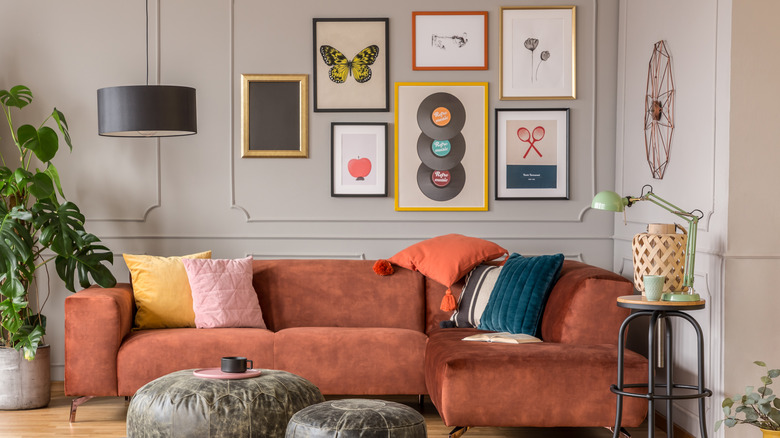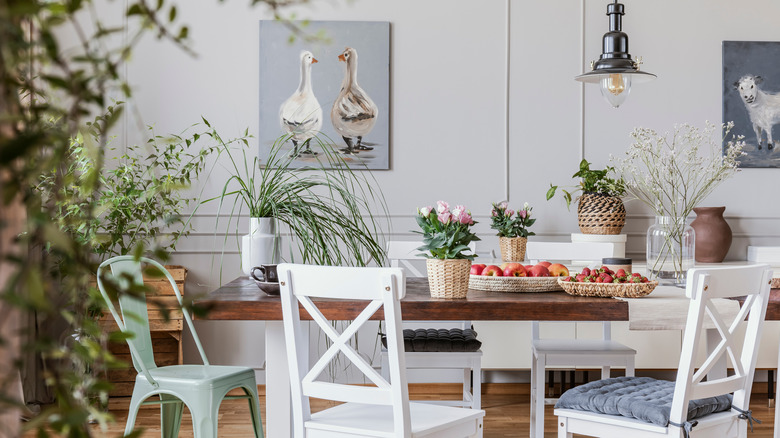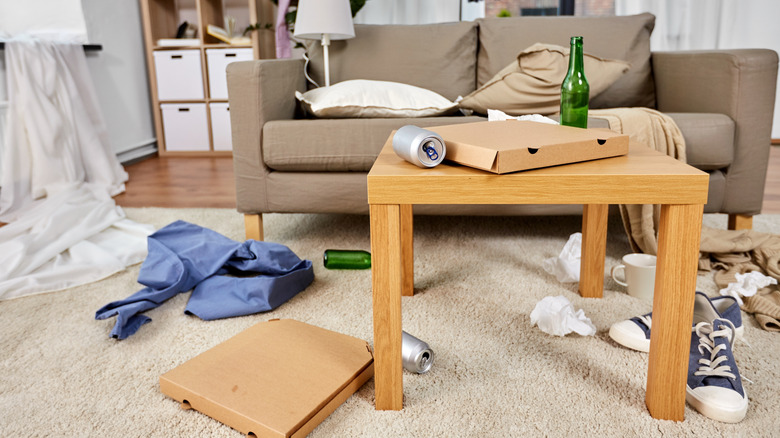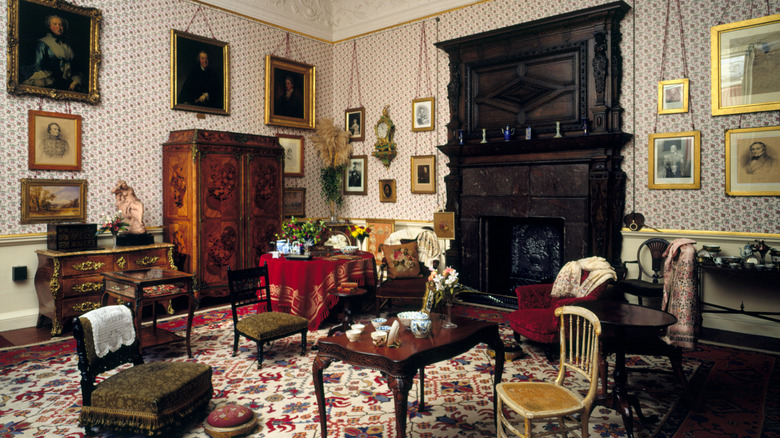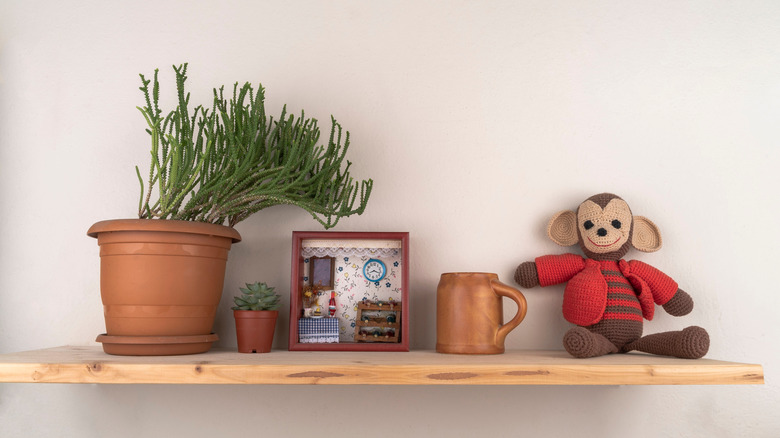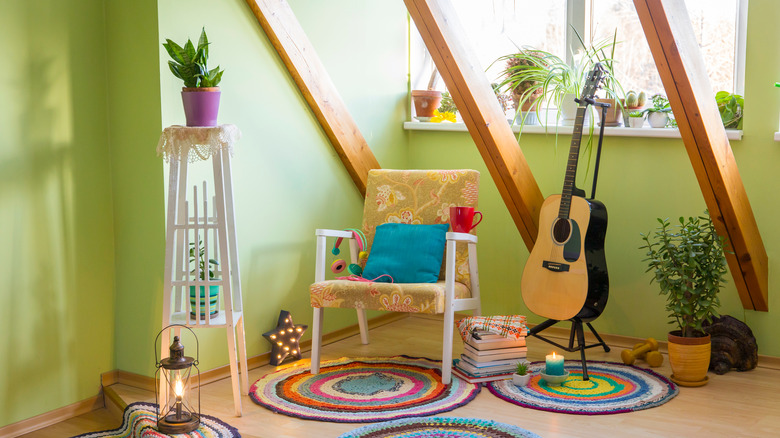What To Know About The Cluttercore Design Trend
After Marie Kondo's popularity explosion over the past few years, the world has been focused on decluttering. Closet cleanouts, minimalist aesthetics, and sneaky storage have dominated our feeds, but recently, TikTok has been pushing back with an answer to this phenomenon — cluttercore. According to Kelly Elko, this booming new aesthetic is a celebration of the items we love and a rejection of the stark minimalism we've grown accustomed to.
After a trend has gone on for a while and it feels overdone, people tend to swing the pendulum back in the opposite direction. Think high-waisted pants, suddenly swapped for a daring pair of low-rise jeans. The same thing is happening with minimalism. People are getting tired of modern, simple interior design and missing the items they put aside to achieve that sleek and clean look. The result is a newfound love for old things and a bold display of just about anything your heart desires.
What is cluttercore?
According to WebMD, clutter can decrease productivity and increase stress. Our brains are wired to interpret visual and sensory stimuli constantly, so being surrounded by a lot of colors, patterns, and textures can overwhelm you. Supporters of cluttercore, however, argue that being around items you love can actually make you happier. Not forcing yourself into one simple box can allow you to showcase trinkets and artworks connected to happy memories. It's a rejection of the idea that our homes should be staged and stark and instead be filled to the brim with pieces of our lives.
Full shelves, bold textures, bright colors, and an overabundance of just about everything are becoming more popular as this trend picks up speed. Instead of your home looking like a staged house, people are leaning further into something that resembles a flea market. Whether it's better for your mental health is still debatable, but there's no denying it's much homier than minimalism.
Cluttercore isn't about actual clutter
Despite the name, cluttercore doesn't actually have anything to do with holding onto unnecessary items. Instead, it's an offshoot of maximalism that allows us to embrace what we have, via Kelly Elko. Instead of hiding your prized possessions away in favor of clean lines and modern art from IKEA, cluttercore argues that you should display these pieces and enjoy them every day; a home should look like a home, not a staged apartment.
Commonly, these unique pieces don't adhere to one specific aesthetic, so cluttercore is unique to each person. Vintage furniture, handmade art, trinkets from travels, and playful patterns are all fair game. It's inherently eclectic and typically works hand-in-hand with lovers of unique, secondhand pieces, but there's no one rulebook to follow — that's the point. Cluttercore is about allowing yourself to explore your style instead of boxing yourself in favor of one hyper-specific look or color scheme.
Cluttercore goes hand-in-hand with vintage
To embrace cluttercore, look no further than your attic. Bring out those items you stowed away simply because they didn't match, or head to your local vintage or thrift store to pick up a few pieces that make your heart happy. Your personality should shine through in your home's aesthetic, so look for items that speak to who you are and what you love, via Kelly Elko. If you're not ready to fully commit to the randomized mix of typical cluttercore, look for pieces with a similar color scheme or vibe. It doesn't have to be perfect, but consistency throughout can bring a bit of order to the chaos.
Because just about any item can fit in, leaning into cluttercore can often result in a mix of influences that span decades or even centuries. Your family's passed-down clock could be right next to a groovy lava lamp, and because everything is pretty randomized, it still makes sense. The cluttercore trend allows you to play around and experiment without strict rules.
It can work for people with ADHD
If you've ever struggled with ADHD, you know how difficult it can be to keep your house clean. Many experts recommend a more minimalist design trend to keep people with ADHD on track and remove excess visual stimuli, but that doesn't work for everyone, via Adders. Remembering to put away items and complete tasks when you don't have the visual reminder right in front of you can leave you with more of a mess than you started with.
Instead, many people with ADHD have found comfort in cluttercore. With this aesthetic, there's no longer the expectation of an immaculate home with no visual interest. According to a 2010 study in the Depression and Anxiety journal, people with ADHD hoard items like trinkets, prefer clutter in their homes, and enjoy the dopamine boost of including fun items throughout the space. Cluttercore becoming a trend is giving people that already like to display their collections a chance to do so without being seen as eccentric.
Cluttercore is all about personal decisions
The best part about cluttercore is that it's unique to you. Instead of other trending design aesthetics that have specific tenets you need to follow to achieve a particular look — think the smooth lines of hygge or the natural textures of Japandi — there's a chance to play around and find what you enjoy. Some people may go full maximalist with bright colors and funky patterns, while others may lean more into a more natural, earth-toned look. If it's about displaying what you love and far away from minimalism, it can count as cluttercore, via Kelly Elko.
The boldness of cluttercore might not be for everyone, but neither is minimalism. This trending aesthetic is just about pushing against perfection and appreciating what you have, and it serves as a lesson for us all. Give yourself a chance to explore, and you might like what you find.
